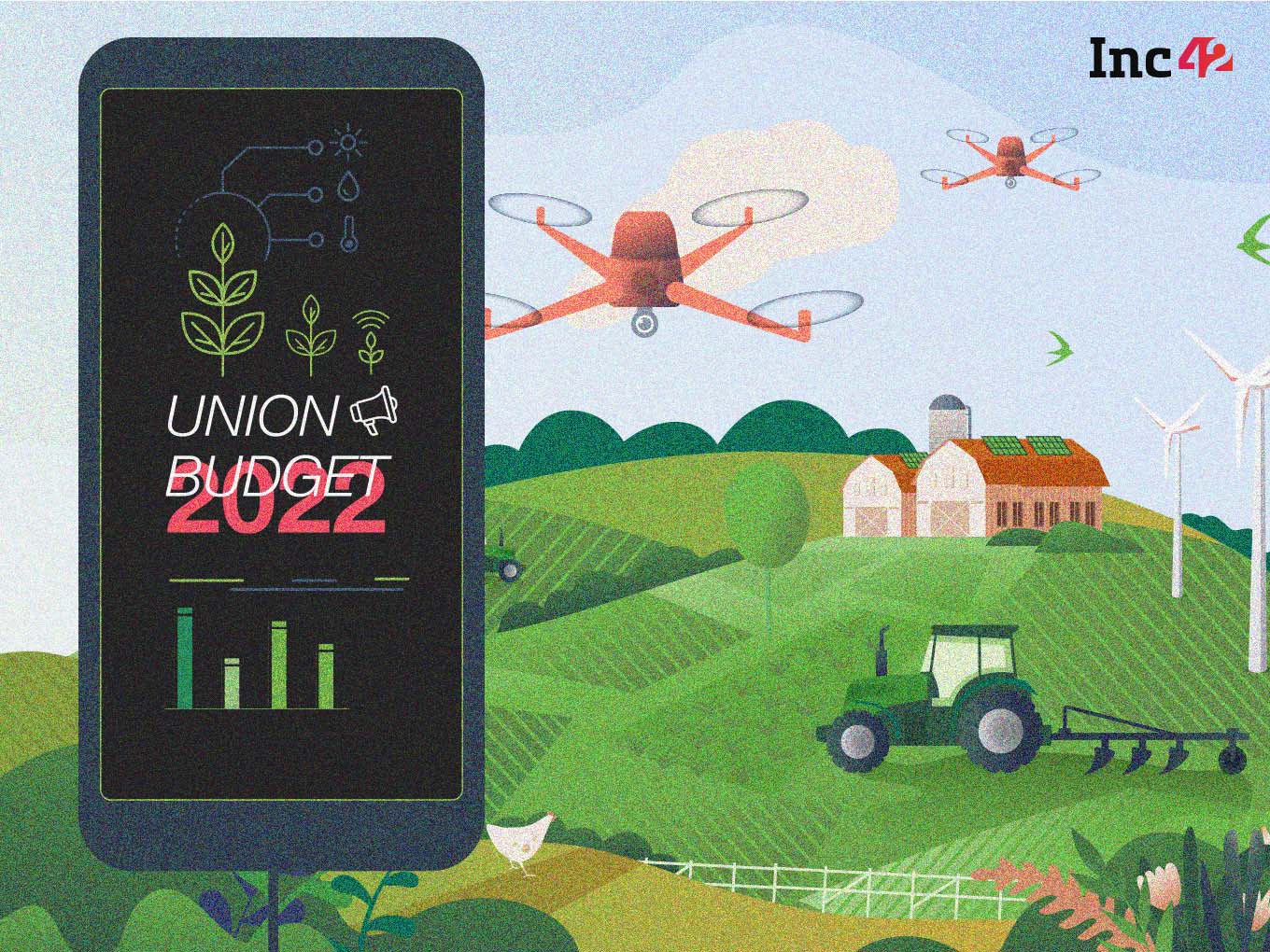
SUMMARY
The government’s recognition of agritech is a paradigm shift for the policy formulation in the sector with innovations at the epicentre
The budget has a vision for agritech and technology to operate as a growth engine with PPP as the mode of delivery in the agriculture sector
The union budget announced key initiatives promising growth of the agriculture sector with agritech playing a crucial role
The Honourable Finance Minister talking about agritech within the first twenty minutes of her budget speech was music to the ears. Agritech, an almost non-existent part of the agriculture sector, has finally gotten the recognition it deserves.
India has over 1,200 post POC agritech startups building solutions for farmers’ issues. The government’s recognition of agritech is a paradigm shift for the policy formulation in the sector with innovations at the epicentre.
There are multiple announcements in the budget that promises growth of the agriculture sector, in which agritech startups will play a crucial role. Some of these are as follows:
Focus On Kisan Drones And Agri Implements
Indian agriculture needs a lot of mechanisation to improve farm productivity and efficiency. With the farm labour becoming scarce and expensive, along with a significant part of agriculture turning feminine (especially horticulture and animal husbandry) – we need a multitude of solutions to mechanize farming including hand-held mechanical tools, tractor driven implements, use of robotics/computer vision and of course, much-awaited use of drones.
We have seen some wonderful startups in this space such as the ones working on drones (Thanos, Marut, DroneAcharya), tools for harvesting (Sickle Innovations), implements marketplace (ToolsVilla), tractor and allied segments (Meratractor, Tractor Junction, Cellestial E Mobility), urea deep placement (Distinct Horizon), bore charging (Urdhvam), weed identification and spray (X Machines, Tartan Sense) .
With regulatory reforms in place, drone application in agriculture is at an inflection point when it comes to agrochemicals/nutrient sprays and data collection. Many crop inputs companies are pivoting to crop solutions companies, through the integration of product and service models. Drones, which are still in pilot stage testing, have a huge role to play in enabling farm services (probably more than tractors and harvesters in a decade from now).
Another use case for drones is the digitisation of land records. While many state governments have digitised the land records, the dynamicity in land boundaries, crops and other agronomic variables call for continuum in data collection at a certain frequency. Drones in addition to satellite imagery, sensors, IoT devices and smartphones together will be able to build such a granular and accurate data stack.
Funding Support For Startups Focusing On Rural Enterprises
The blended pool of capital for investment into agri startups through NABARD is another key announcement of the budget. The capital will be used for value addition, IT tools application and providing farming as a service.
Coincidently, both agritech startup and the FPO ecosystem in India evolved almost at the same time. However, both ecosystems are still not osmotic with each other. The power of innovation coupled with the power of aggregation of farmers and farm produce is the panacea for most farming problems.
Initially, very few startups thought of FPO as a go-to-market. Though it is becoming evident that FPOs will be one of the primary target customer segments for agritech startups going forward. I see this symbiotic relationship playing a pivotal role in enabling FPOs access to markets, credit, inputs and advisory. Platforms like Innoterra, Samunnati, BigHaat, Unnati, DeHaat, Falca, SMP Agro, EasyLokal are some of the startups who have demonstrated good traction with FPOs.
Farm-Level Processing And Value Addition
By promoting primary and secondary processing and value chain addition in agriculture, the budget will increase farmer income. Farm-level processing can help farmers and farmer groups sell products and brands, instead of commodities.
Primary processing can help build “farmer brands” especially in commoditised categories like fruits, vegetables, rice, spices etc. This includes sorting, grading, and packing with access to new-age distribution models (like WayCool, DistriCo, Udaan, SuperZop, ShopKirana) Traceability solutions by Innotrace, BWS, TraceX, SourceTrace etc can further build technology-enabled-trust between farmers and consumers.
Farm-level value addition can also create new models of rural entrepreneurship as demonstrated by startups such as Our Foods, S4S Technologies (in crops); Promethean, Inficold (in dairy), Krishi Sahyog, and KrishiKan (in spices). Many of these models have created a livelihood for micro-entrepreneurs to the tune of INR 5,000 to INR 10,000 per month.
With a little bit of push in asset financing (under Agri Infra Fund, which has a corpus of INR 1,00,000 crores for concessional debt); farm level asset creation can get further momentum. The missing narrative in agritech solutions so far is the humungous power of driving rural entrepreneurship models, thus creating jobs where it is needed the most.
Building Rural Infrastructure
Building both physical and digital infrastructure is key to farmer access to processors, distributors and bankers. The transactional cost of the first mile and last mile is prohibitive for scaling farmer-centric models. Connecting villages through roads, rails, cargo terminals and logistics hubs as well as digitally through broadband as envisaged in the budget, can significantly reduce the cost of farm produce aggregation and logistics.
Warehousing startups like Arya, Ergos, Apna Godam and market linkage startups with a focus on first/last mile like Agrowave, Behtar Zindagi can be big beneficiaries of this development.
Post Offices To Double Up As Banking Channels
Banks are mandated to lend 18% of their book to agriculture including farmers and the value chain. However, the transactional cost of lending continues to be high due to poor or scattered branch networks. Hence, almost two-thirds of farmers are deprived of access to institutional credit.
Many banks and NBFCs are already engaging with agritechs and fintechs for farmer onboarding (like Hesa, Spice Money, Whatsloan, Jai Kisan, GreyMatter, Agrifi), risk assessment and monitoring (like SatSure, CropIn) and many market linkage startups as mentioned earlier, for loan recovery.
There are about 1,55,000post offices in the country, with about 1,40,000 in rural areas (approx. 1 in 4 villages). The challenge of farmer access can be mitigated to a large extent if the core banking services like payments, withdrawal, deposits, savings and loans can be channelled through post offices.
Millets As Key Target Crop
Government support for millet production, processing, branding is a great initiative. Millets lost out to rice and wheat at the time of the green revolution and its acreage reduced over time. It’s time to boost millets as it is one of the most climate-resilient crops with very high nutritional value and low glycaemic index.
India needs a crop rotation policy to conserve its natural resources. This calls for substituting water-guzzling crops like rice and sugarcane with crops like millets or oilseeds (which we continue to import). In addition to crop rotation, we should also build income-diversification policies for the farmer, augmenting their income through fisheries, poultry, dairy, beekeeping, sericulture etc.
It’s time we develop a climate resilience (risk) index for all agro-climatic zones to synch crop rotation and other policies for the sector with climate as a lens.
Promoting Circular Economy
Another key announcement is the mixing of pallets made from agricultural waste in thermal fired plants to the extent of 5-7%. This will incentivise farmers to use stubbles and other agricultural waste as fuel for additional income and reduction of carbon emissions.
Redesigning Curriculum In Agricultural Universities
For a change, agritech sector is no more capital-starved (attracting almost USD 2 bn out of cumulative USD 2.5 bn in the last 36 months). Though talent continues to be in scarcity. Agritech needs people from diverse disciplines such as data science, behavioural science, agronomy, natural farming, hydrology, etc.
The budget shows government intent for curriculum revision to cater to the emerging needs of the sector. Clearly, agricultural universities and research institutions need to be turned into reservoirs and breeding grounds of talent that this sector would need, in time to come.
Furthermore, the budget also talks about chemical-free natural farming which is possible in certain regions/clusters. As a starting point, it will be good to identify crops/ regions/ clusters, which are fertile enough and most suited for farming without chemicals.
The budget’s vision for agritech and technology as a growth engine with PPP as a mode of delivery in the agriculture sector is refreshing. We should build upon this narrative for it to become more attractive to both entrepreneurs and investors. Kudos to the Honorable FM for embracing and igniting agritech like never before!!
The author is an investor, mentor and board member with many foodtech and agritech start-ups in India and overseas. He serves as Venture Partner with Bharat Innovation Fund, co-founder of ThinkAg, chairman of FICCI task force for agri startups and strategic advisor to Innoterra. The views expressed in this article are personal.


























